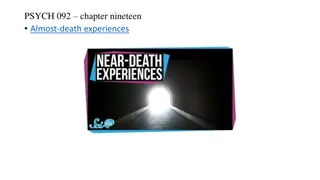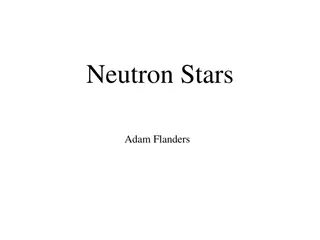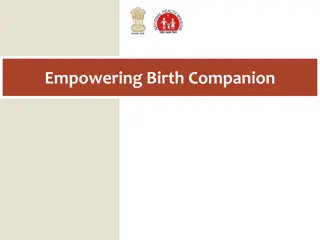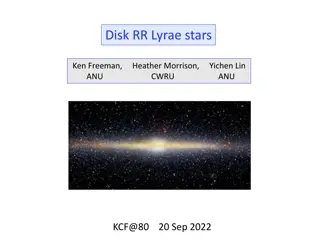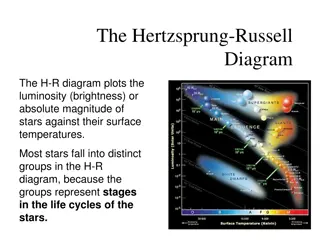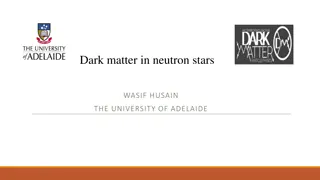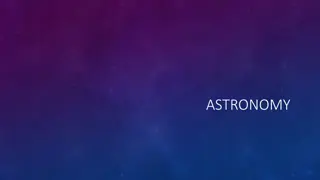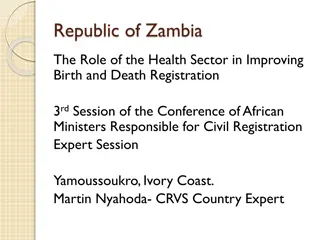The Birth and Death of Stars
Stars are born in giant clouds of dust and gas through nuclear fusion reactions. As they evolve, some stars become Red Giants before eventually dying. Explore the life cycle of stars in this informative online lesson with captivating visuals.
Download Presentation

Please find below an Image/Link to download the presentation.
The content on the website is provided AS IS for your information and personal use only. It may not be sold, licensed, or shared on other websites without obtaining consent from the author.If you encounter any issues during the download, it is possible that the publisher has removed the file from their server.
You are allowed to download the files provided on this website for personal or commercial use, subject to the condition that they are used lawfully. All files are the property of their respective owners.
The content on the website is provided AS IS for your information and personal use only. It may not be sold, licensed, or shared on other websites without obtaining consent from the author.
E N D
Presentation Transcript
The Birth and Death of Stars On-line Lesson
On-line Lessons: The Birth and Death of Stars What are Stars? Stars are large balls of hot gas. They look small because they are a long way away, but in fact many are bigger and brighter than the Sun. The heat of the star is made in the centre by nuclear fusion reactions. There are lots of different colours and sizes of star.
On-line Lessons: The Birth and Death of Stars How are stars made? Stars are made (or born ) in giant clouds of dust and gas. Sometimes part of the cloud shrinks because of gravity. As it shrinks it becomes hotter and when it is hot enough, nuclear reactions can start in the centre .. and A Star is Born!
On-line Lessons: The Birth and Death of Stars Watching stars being born The Bubble Nebula Here you can see the old dust and gas being blown away by the heat of the new star. Image from the Liverpool Telescope
On-line Lessons: The Birth and Death of Stars What happens next? Once nuclear fusion is producing heat in the centre of the new star, this heats stops the rest of the star collapsing. The star then stays almost exactly the same for a long time (about 10 billion years for a star like the Sun). The balance between gravity trying to make the star shrink and heat holding it up is called Thermodynamic Equilibrium.
On-line Lessons: The Birth and Death of Stars The life of a star During its life a star will not change very much. However, different stars are different colour, size and brightness. The bigger a star, the hotter and brighter it is. Hot stars are Blue. Smaller stars are less bright, cooler and Red. Because they are so hot, the bigger stars actually have shorter lives than the small, cool ones.
On-line Lessons: The Birth and Death of Stars How does a star die ? Eventually, the hydrogen (the fuel for the nuclear fusion) in the centre of the star will run out. No new heat is made and gravity will take over and the centre of the star will shrink. This makes the very outside of the star float up and cool down, making the star look much bigger and redder - a Red Giant star. Antares a Red Giant
On-line Lessons: The Birth and Death of Stars The second Red Giant stage As the centre collapses, it becomes very hot again, eventually getting hot enough to start a new kind of nuclear fusion with Helium as the fuel. Then the Red Giant shrinks and the star looks normal again. This does not last very long, though, as the Helium runs out very quickly and again the star forms a Red Giant.
On-line Lessons: The Birth and Death of Stars The end of a Sun-like star For a star like the Sun, no more nuclear fusion can take place, so the centre of the star will then keep collapsing. Simulation of the Death of the Sun Eventually it can become almost as small as the Earth, but with the same mass as a whole star! This very dense object is called a White Dwarf. A piece of White Dwarf the size of a mobile phone would weigh as much as an elephant on the Earth!
On-line Lessons: The Birth and Death of Stars The end of a Sun-like star The outer parts of the star (that formed the Red Giant) then drift off into space and cool down making a Planetary Nebula. Planetary nebulae have nothing to do with planets, of course, they just look a bit like them in small telescopes! Here you can see a planetary nebula called M57 with its White Dwarf in the middle. Image from the Liverpool Telescope
On-line Lessons: The Birth and Death of Stars The end of a massive star For more massive (bigger) stars than the Sun, many more types of nuclear fusion can take place. This means several more Red Giant stages. Finally, there are However, eventually even the biggest stars run out of fuel and finally collapse. For the biggest stars, this collapse causes a huge explosion called a Supernova! A Supernova can be brighter than an entire galaxy of 100,000,000,000 stars! Simulation of the Death of the massive Star
On-line Lessons: The Birth and Death of Stars What is left after a Supernova? Because the star was so big, the collapse does not stop even with a White Dwarf, but an even more dense object called a Neutron Star is made. The density of a Neutron star is about 1x1018 kg/m3(that is 1,000,000,000,000,000,000!) Sometimes the collapse cannot stop at all and a Black Hole is made, from which not even light can escape! The debris of the explosion is blown away and forms a glowing cloud called a Supernova Remnant.
On-line Lessons: The Birth and Death of Stars Image from the European Southern The Crab Supernova Remnant Observatory Very Large Telescope
On-line Lessons: The Birth and Death of Stars Birth and Death of Stars - Summary Stars form in clouds of gas. Heat from nuclear fusion, and gravity balance. When the hydrogen fuel runs out, a Red Giant is formed. For Sun-like stars, a White Dwarf and Planetary Nebula are left. For massive stars, a Supernova explosion leaves behind a Supernova Remnant and a Neutron Star or perhaps even a Black Hole.
On-line Lessons: The Birth and Death of Stars White Dwarf and Planetary Nebula Collapsing cloud Sun-like stars A new star Supernova Remnant and Neutron Star Red Giant Massive stars Birth and Death of Stars - Summary






